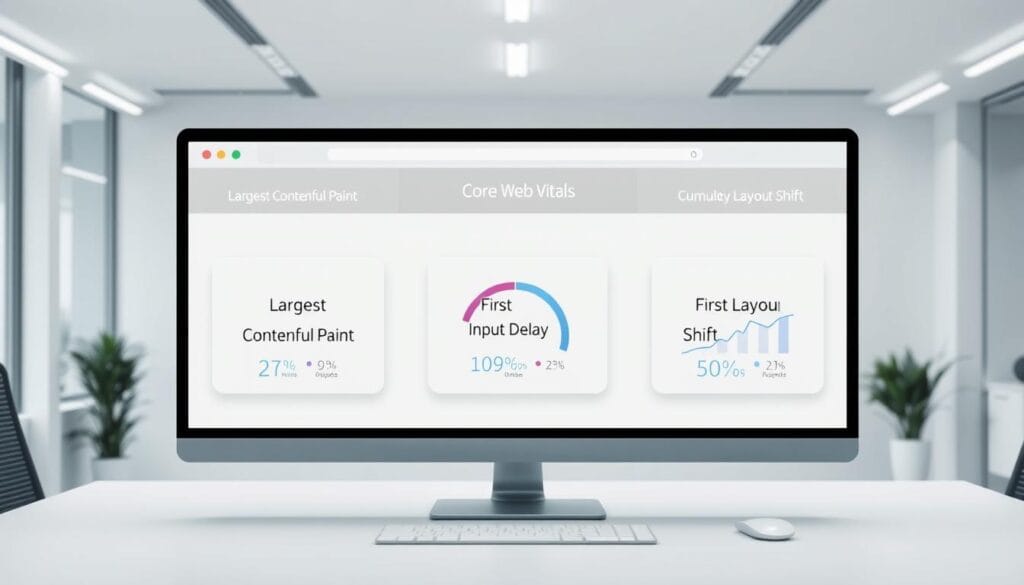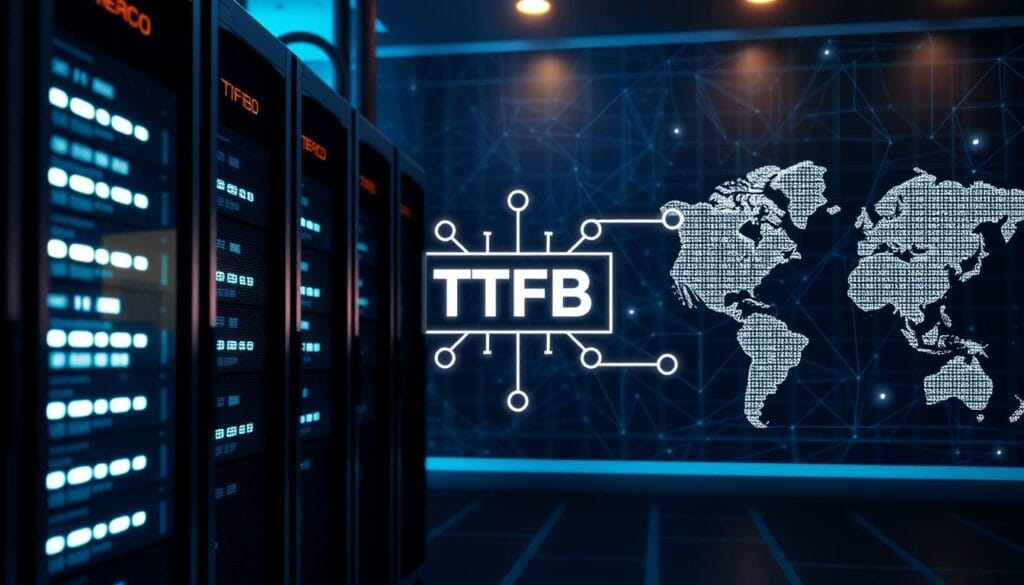Fact: users often decide whether to engage in under 1 second — a single delay can cost millions in lost conversions for premium brands.
We map milliseconds to money. In elite categories, proving value inside the 0.3–3 second attention window is the only metric that truly matters.
Our playbook ties performance to measurable ROI: lower CAC, higher conversion rates, better search visibility, and increased lifetime value. We benchmark Core Web Vitals at the 75th percentile, use field and lab tools like PageSpeed Insights, GTmetrix, and Pingdom, and rank fixes by economic impact.
Expect a pragmatic, E-E-A-T-aligned guide with surgical tactics — image and media governance, render-blocking asset control, TTFB, HTTP/2, CDN and caching layers — all prioritized to protect brand perception and drive revenue.
We align executives and engineering on one outcome: measurable gains in conversions, average order value, and revenue per session by attacking load times at true leverage points.
Key Takeaways
- Milliseconds matter: proving value fast lowers bounce and lifts conversion.
- Benchmark Core Web Vitals at the 75th percentile across desktop and mobile.
- Use field and lab tools (PageSpeed Insights, GTmetrix, Pingdom) for diagnostics.
- Prioritize fixes by ROI: media, render-blockers, CDN, and caching first.
- Monitor continuously to prevent regressions and protect brand perception.
- We act as your growth command center — strategy, execution, and analytics tied to the balance sheet.
The speed-to-revenue link: why milliseconds matter for traffic, rankings, and conversions
Small drops in load time unlock outsized gains in conversions and rankings. We translate technical gains into clear business outcomes for high-ticket operators.
Impact on engagement and conversion
- Faster pages reduce bounce and lift dwell; for premium offers this raises qualified leads and close rates.
- Every extra second increases abandonment and CAC; every second removed improves trust and checkout completion.
- Hidden culprits—large images, third-party scripts, and render-blocking CSS/JS—can silently tax visitors at scale.
Google factors web vitals into ranking. Targets to watch: LCP ≤ 2.5s, FID ≤ 100ms (or TBT in lab), and CLS ≤ 0.1 at the 75th percentile. Improving these metrics expands top-of-funnel visibility and compound revenue.
| Metric | Business effect | Target |
|---|---|---|
| LCP | Fewer early exits, higher conversions | ≤ 2.5s |
| FID / TBT | Faster interactivity, better checkout completion | FID ≤ 100ms / Low TBT |
| CLS | Stable layouts, higher trust for high-ticket purchases | ≤ 0.1 |
We recommend governance: set performance budgets for critical pages and correlate LCP and CLS gains with CVR, AOV, and ROAS to prioritize fixes that drive revenue.
Benchmark first: the Website Speed Optimization metrics that matter in 2025
We define a crisp benchmark framework so teams measure what drives revenue. A short list of defensible targets aligns executives and engineering on one outcome: faster, more trustworthy pages that convert.

Core thresholds to hit
Core Web Vitals targets at the 75th percentile: LCP ≤ 2.5s, FID ≤ 100ms (or low lab TBT), CLS ≤ 0.1. Use these numbers as pass/fail gates across key templates and traffic segments.
Field vs. lab: what to use when
Field data captures real user conditions across devices and networks. Lab data reproduces faults deterministically so engineers can iterate quickly.
Tools and dual targets
- PageSpeed Insights for combined field + lab CWV context.
- GTmetrix for deep waterfalls and filmstrip analysis.
- Pingdom for geographic checks and page-level grades.
Set dual targets—rigorous desktop goals and stricter mobile device targets. Benchmark by device class, geography, and network (3G/4G/5G). Baseline every key page, set ownership, and report weekly to avoid regressions.
Diagnose bottlenecks with the right tools and data
The fastest path to measurable gains is built on accurate data and the right investigative tools. We start with field truth, then validate with repeatable tests so leaders can fund the fixes that move revenue.
Real User Monitoring vs. Synthetic Monitoring
Real User Monitoring captures how actual users experience the site across devices and networks. It shows the business truth you must track to prioritize work.
Synthetic monitoring simulates journeys to give stable baselines and SLA checks. Use it to validate fixes before rollouts and to detect regressions early.
Waterfall and filmstrip analysis
Read waterfalls to spot long main-thread tasks, oversized images, heavy third-party resources, and slow domains. Filmstrips map perceived time to first meaningful content.
“Convert a single blocking resource to async/defer or inline critical CSS and you often unlock disproportionate gains.”
- Ask executives: show RUM trends tied to conversion metrics.
- Ask engineers: inspect waterfall timing, DNS/connect delays, and main-thread tasks in the browser.
- Embed CI checks and dashboards from PageSpeed Insights, GTmetrix, and Pingdom for ongoing visibility.
Win big and fast with image and media optimization
Optimizing visual assets delivers visible ROI in days, not months. We target media first because images carry the largest bytes and the fastest returns. This is a high-leverage, low-risk play for premium brands.
- Standardize formats: JPEG for photos, PNG for transparency, WebP where supported, and SVG for icons and logos.
- Responsive delivery: serve srcset variants so the browser picks the smallest viable file by screen and connection.
- Compress aggressively: use visually lossless settings to shrink file sizes while protecting brand aesthetics.
Developer-ready steps
Lazy-load offscreen image files and use LQIPs for perceived loading. Replace heavy animated GIFs with short video or CSS motion. Align background colors with primary assets to reduce visible jumps.
Governance and measurement: enforce max dimensions, automate compression, audit the media library, and enable CDN image resizing. Track total image bytes and tie reductions to LCP and conversion lift for clear ROI.
Tame CSS and JavaScript to unblock rendering
Trim the front‑end fat so the browser can deliver the hero content immediately. We focus on shipping the conversion frame first, then loading extras after the primary paint.
Minify, bundle, and deliver critical styles
Every CSS in the head blocks render by default. We generate and inline Critical CSS for above‑the‑fold content so the main hero paints instantly.
Non‑essential styles load asynchronously or via code‑split files. We minify and bundle CSS/JS/HTML to shrink files and reduce request overhead while balancing HTTP/2 benefits.
Defer scripts and sequence loading
Set noncritical scripts to async or defer and sequence them after primary content. This lets the page become interactive before heavier logic runs.
We lazy‑load widgets, carousels, and any third‑party widget so initial loading stays focused on conversion content.
Govern third‑party code and protect the main thread
Audit every external resource and tag each with a business owner and ROI case. If a script doesn’t earn its keep, we defer, self‑host, or remove it.
We protect the browser’s main thread by splitting long tasks, deferring heavy functions, and enforcing a performance budget per page type.
“Inline critical CSS, async nonessential scripts, and audit third parties to turn bytes into conversion.”
Validate with filmstrip and timing metrics and document the playbook so future releases ship fast by default.
Cut wait time at the origin: hosting, TTFB, and HTTP/2
Origin responsiveness sets the baseline for every user interaction and conversion. We treat the origin as an infrastructure decision that directly affects traffic, rankings, and revenue.
Executive decision tree: choose SSD-backed hosting first. Then pick an architecture—VPS for predictable loads, dedicated for high control, or serverless for unpredictable bursts and compliance needs.

Reduce Time to First Byte
We benchmark TTFB as a leading indicator: <200ms excellent, 200–500ms acceptable, >600ms needs investigation. Reduce TTFB by streamlining app logic, caching hot queries, adding indexes, and moving blocking tasks off the request path.
Upgrade protocol and scale
HTTP/2 enables multiplexing, header compression, and prioritization so many small resources arrive faster over one connection. Right‑size instances and autoscaling to handle campaigns without overspend.
| Decision | Why it matters | Action |
|---|---|---|
| SSD-backed hosting | Lower I/O latency improves TTFB and overall performance | Move from HDD to NVMe SSD; verify disk IOPS |
| Architecture choice | Matches cost to traffic pattern and compliance | VPS for steady loads, dedicated for control, serverless for bursts |
| HTTP/2 & edge cache | Parallel delivery and reduced network hops for images and content | Enable HTTP/2 and deploy CDN + strategic API caching |
Instrumentation and resilience: measure origin metrics by application, database, and network. Implement failover CDNs, health checks, and capacity tests so gains persist as content and campaigns evolve.
Accelerate global delivery with a CDN
Delivering assets from the nearest server turns distance into an invisible detail for buyers. For global brands, consistent delivery boosts conversions and protects brand perception.
Why a CDN matters: CDNs cache static content across edge locations so the nearest node serves images, CSS, and JavaScript. That collapse of geographic distance reduces network latency and eases origin load during spikes.
How CDNs reduce latency for images, CSS, and JavaScript
We offload heavy files to the edge and enable on‑the‑fly transformations. The result: smaller file sizes per device and faster asset delivery for visitors worldwide.
- Edge caching: serves assets from nearby POPs to shrink round trips.
- Image transforms: resize and format negotiate at the edge to cut bytes.
- TLS & HTTP/2: secure, parallel delivery without a speed penalty.
Measuring CDN impact across regions and devices
Measure before and after across markets and device classes. Track load times, LCP, and conversion lift by country.
| Metric | Why it matters | Target |
|---|---|---|
| Regional LCP | Shows edge effectiveness | Improve by ≥20% |
| Bytes from origin | Indicates offload level | Reduce by ≥50% |
| Conversion lift | Business ROI | Measure cohorts pre/post |
We validate ROI by integrating CDN logs into analytics, tuning TTLs, and enforcing purging and fallback rules so campaigns and releases move with confidence.
Lean pages load faster: reduce requests, cache smartly, and prefetch wisely
A lighter page is a faster funnel; we remove, cache, and hint to protect revenue. Start by auditing requests and counting the number of assets that don’t move conversions.
Trim plugins, widgets, and fonts
We cut plugins, third‑party widgets, and extra font weights first. Fewer requests and smaller files free the browser to render the hero content faster.
Caching layers explained
Eliminate, then cache. Browser caching handles static assets. Page caching serves full HTML where appropriate. Object caching speeds expensive queries. Bytecode caches PHP/JS for faster execution.
Prefetch, preconnect, and prerender that move the needle
We add dns-prefetch and preconnect for critical domains to reduce negotiation time. Use prefetch for predictable next-page files and prerender only for high-confidence navigations.
| Action | Why it matters | Expected ROI |
|---|---|---|
| Trim plugins & fonts | Fewer requests and smaller payloads | Lower LCP, higher CVR |
| Layered caching | Faster repeat responses across the site | Reduced TTFB, better throughput |
| Connection hints | Faster resource negotiation for critical domains | Smoother perceived load and TTI gains |
Governance: set a strict performance budget per page and block merges that exceed it. Track Core Web and Web Vitals to verify that our lean approach raises conversions, not just metrics.
Mobile-first performance: design for smaller screens and slower networks
Designing for handhelds forces clarity: smaller screens demand ruthless prioritization of what users see first.
Testing with throttled CPU, network, and emulators
We emulate real-world conditions with mobile emulators and throttled CPU/network to surface failures hidden on powerful machines.
Run tests at 3G/4G profiles and on a mix of physical devices to catch delayed interactivity and heavy main‑thread tasks early.
Optimize layout shifts and interactivity for on-the-go users
Protect conversions by fixing CLS: set explicit image and component dimensions and reserve space for ads and embeds.
- Prioritize tappable targets and generous hit areas to reduce friction on small screens.
- Reduce JavaScript on mobile devices and lazy-load offscreen image and media assets.
- Serve device-aware images and adaptive quality based on connection to lower bytes without losing brand fidelity.
“Our mobile wins are not desktop side effects; they are a distinct milestone we validate against core web vitals.”
We institutionalize mobile checks in QA so site releases never regress and premium buyers keep converting on the go.
Website Speed Optimization roadmap: from audit to compounding ROI
Start with a facts-first audit that ranks every fix by dollar impact and implementation cost.
We map core web vitals and other metrics to conversion, AOV, and CAC to reveal the highest-return plays.
Quick wins—images, critical CSS, and caching—go first.
Structural work (TTFB, CDN, hosting) follows in planned sprints.
Prioritize fixes by cost, effort, and revenue impact
We group initiatives into sprints by low, medium, and high cost.
Each task ties to a KPI so leaders approve work that moves the needle.
Create a monitoring cadence and regression guardrails
We run RUM and synthetic tools in parallel and automate alerts when thresholds break.
CI gates fail builds that bloat files or worsen LCP/CLS, protecting gains across releases.
Tie improvements to revenue KPIs: conversion rate, AOV, and CAC payback
- Align dashboards so performance rollups sit beside revenue charts.
- Schedule quarterly resilience tests for traffic surges and campaigns.
- Publish an internal guide with ownership, SLAs, and asset governance rules for images and third-party scripts.
| Decision | Impact | Timeline | KPI |
|---|---|---|---|
| Image governance & compression | Large byte reduction, faster LCP | 1–2 sprints | LCP, bytes from origin |
| Inline critical CSS & defer scripts | Improve first paint and TTI | 1 sprint | FCP, TBT |
| CDN + TTFB work | Persistent global gains | 2–4 sprints | Regional LCP, TTFB |
We operationalize Macro Webber’s WebberXSuite™ and A.C.E.S. Framework to systematize improvements and compound ROI.
This is an executive-ready plan that turns technical work into measurable revenue and lower risk.
Conclusion
The browser window is a battlefield—win those initial 0.3–3 seconds or lose the visitor.
We’ve shown how shaving times inside that attention window transforms perception, conversion, and lifetime value for premium brands. Tune TTFB, adopt HTTP/2, enforce budgets, streamline files and images, and protect Core Web Vitals to compound gains.
Performance is dynamic: campaigns, integrations, and content change behavior. Continuous monitoring with the right tools and data keeps wins from slipping away.
Act now: our Growth Blueprint compresses months of trial and error into a prioritized plan. Book a consultation to activate WebberXSuite™ and the A.C.E.S. Framework—let’s engineer measurable ROI in weeks, not quarters.



